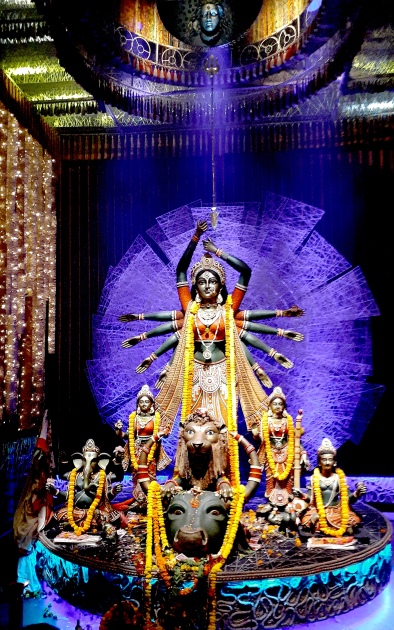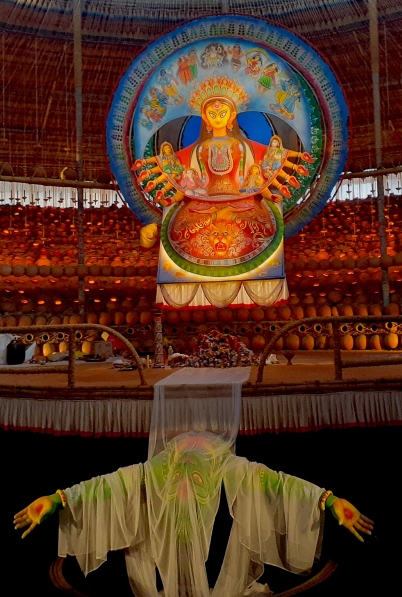It’s time for my annual blog post on Durga Puja. Like the previous years, I will review the literature published before and the movies released during this year’s festival. Then I will showcase some of the best puja pandals in Kolkata for this year.
Literature:
I have read this year’s Pujabarshiki Anandamela almost in its entirety, and Sharodiya Desh and Sharodiya Anandabazar Patrika in bits and pieces. I am looking forward to reading more of the latter two magazines in the upcoming weeks. Here’s a short review of the writings I found noteworthy in these magazines from what I read so far .
Hensehare Hunshiar (Stay alert in Henshehar) by Debashis Bandyopadhyay (teenage mystery fiction novel)- published in Pujabarshiki Anandamela:

Since last year, the writer Debashis Bandyopadhyay has apparently switched from “Bhubandadu” series (adventures of an old history professor named Bhubandadu and his grandsons and grand-daughters, all set in a historical context) to “Kaga- Boga” series — adventures of police officer/ detective Kantik Ganguly (Kaga) and his accomplice Boga (I forgot his full name, it’s rarely mentioned), who is the narrator of the stories. I missed the “Kaga-Boga” novel in last year’s Anandamela, which made it difficult initially for me to comprehend what was going on in the 2nd novel in this series, “Hensehare Hunshiar”. What added to the difficulty was the strange way the story has been narrated: dream sequences, surreal imagery, and bizarre characters.
There is a clear inspiration from Sukumar Ray’s “HoJoBoRoLo” with all the Bengali idioms taking some real shape in the novel. Just like “HoJoBoRoLo” has the characters Udho and Budho inspired from the colloquial Bengali phrase “Udhor pindi budhor ghare”, this novel has the characters Kanamama and Neimama based on the phrase “Neimamar cheye kanamama bhalo”. But this novel is much longer than “HoJoBoRoLo” and has an additional mystery component — hunt for some hidden treasure, references to which have been made through various poems and riddles. It is the job of Kaga and Boga to solve those riddles and get to the treasure. So in that sense, the novel is similar to any novel from the celebrated “Adbhuture” series by veteran writer Sirshendu Mukhopadhyay. With Sirshendu’s series on a decline over the last decade, most probably due to his advanced age, it will cause utter delight to hardcore Anandamela fans like me if Debashis Bandyopdhyay carries his torch in the modern day and ushers in a new era in the mystery teen fiction writing genre in Bengal.
Brikhha Anubadok (Tree Translator) by Srijato in Sharodiya Desh:

Ever since reading the famous Bengali poet Srijato’s novel “Tarabhora Akasher Niche” in Sharodiya Anandabazar Patrika two years back, I have been looking forward to the next piece of prose that will come out of his pen. This new novel of his, “Brikhha Anubadok” , doesn’t disappoint in this regard. The central theme of “Tarabhora Akasher Niche” was the artwork of Van Gogh, and how it impacted a schrizophrenia patient Ritwik in modern day Calcutta. The central theme of “Brikhha Anubadok” is the connection between the poetry of English poet Sylvia Plath and that of Bengali poet Jibananda Das. Also, the novel throughly discusses the difficulty associated with translating their works, as faced by an old English scholar William Bright, his daughter Carole, and a young Bengali scholar Samyak, whom Carole meets at a poetry workshop in a small picturesque town in Wales, UK.
Carole and Samyak have been tagged together by the workshop-organizers for a joint session on English and Bengali poetry, where Carole is supposed to read her English translations of Jibanananda’s poems (I have translated some myself in an earlier post in this blog) and Samyak is supposed to read his Bengali translations of Slyvia Plath’s poems. Much expectedly, Carole and Samyak fall in love as they stroll around the town, which seems to be a paradise for bibliophiles with all its bookstores, stacked with old books, and idyllic coffee shops. The story of Carole’s father, Professor Bright, runs in parallel; he is suffering from alzheimer’s disease and lives in an old-age home, next to the sea. Though he can see the sea from his balcony everyday, he is not allowed to get close to it by the authorities. This separation, coupled with disillusion regarding his lifelong work on translation of poetry, increases his mental anguish.
Behind the frustration connected to translation, I feel there is a larger frustration related to depicting the complex emotions, felt in reality, and the nature of reality itself in a written language; this frustration pervades the novel. It is quite similar to the frustration faced by Van Gogh and Ritwik in their quest for capturing reality in its finest essence on canvas, in “Tarabhora Akasher Niche”. This, what I feel, is the limitation of any artistic medium, be it painting, music, or poetry. Art, by nature, is subjective and cannot depict reality in a deterministic way science can. It is true that modern-day science is still far from capturing all the fine emotions we feel as human beings. But, I feel, that is the limitation of the tools we have at our disposal to do science currently, and not a limitation of the scientific method itself. Hence, I feel the hope really lies in pursuing science and connecting it with different mediums of art rather than discarding science altogether and just indulging in arts which artists, including the writer here, often tend to do.
In any case, Srijato writes this novel beautifully, just as I had expected from this great modern day Bengali poet. It almost reads like a long prose-poem, full of vivid imagery, and is certainly worth a second read.
Movies:
Mitin Mashi (Aunt Mitin), directed by Arindam Sil, based on Bengali teenage detective fiction series by late writer Suchitra Bhattacharya
This movie is adapted from one of the books in the teenage detective fiction series, called “Mitin Mashi”, centred around a female sleuth Mitin Mashi and her accomplice Tupur. This series is much more contemporary compared to other series in the same genre, like Feluda, Kakababu, or Arjun; it used to come out in Pujabarshiki Anandamela every year when I was finishing my high school. However, the writer Suchitra Bhattacharya had an untimely death, and the series got terminated. Though I was never a fan of the Mitin Mashi novels (the plot was never as complex and as satisfying as a Feluda or an Arjun story), I was curious to check out its first movie rendition. And I wasn’t disappointed.
Koel Mallick plays the character of Mitin Mashi with a lot of maturity in the movie. The sharpness and deductive ability, characteristic of a fictional sleuth, exists in her rendition of Mitin Mashi. The sharpness is also accompanied by a touch of compassion, which I often found missing in the male detectives in the same genre. The plot is also pretty interesting; the other actors are apt in their performance as well. Overall, the first Mitin Mashi movie provides an enjoyable two-hour-long experience in the theater. Now, I am looking forward to more movies in this new franchise.
Puja Pandals:
The beautiful display of street art in all corners of Calcutta during the Durga Puja week, in the form of puja pandals with various themes, is something very unique about the city. In all these years, I have tried to look for similar celebration of any other festival in any other part of the world, and I have only been disappointed. Here are the pictures of a few pandals from this year’s Puja.
Colorful interior decorations and lighting of Mudiali Club, Tollygunge
Interior decorations of Debdaru Phatak, Behala, themed around middle-class Bengalis’ lifestyle

The always gorgeous idol of the divine at Shibmandir Sarbojonin, Tollygunge

TheDurga idol of Naktala Udayan Sangh, a very popular pandal in this year’s puja
That’s all for this year’s festival. Aschhe bochhor abar hobe!!!




